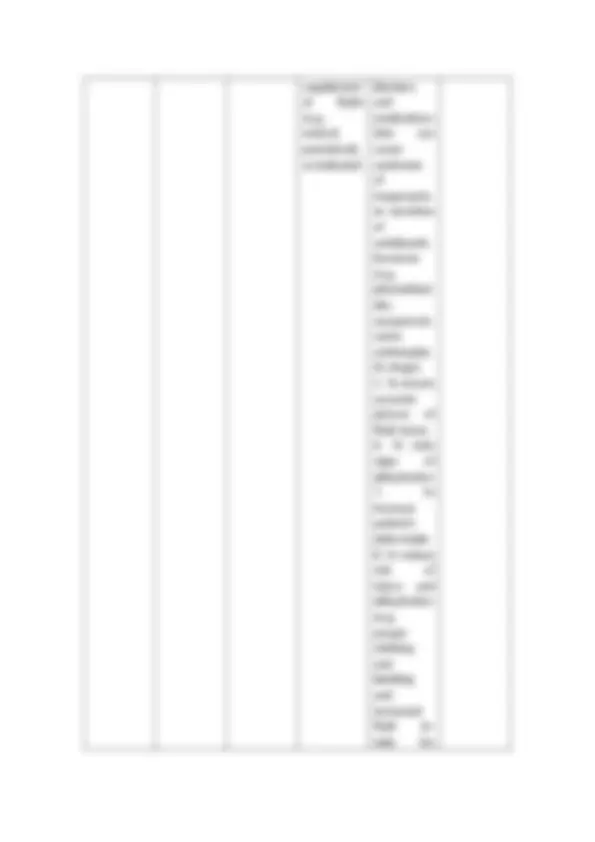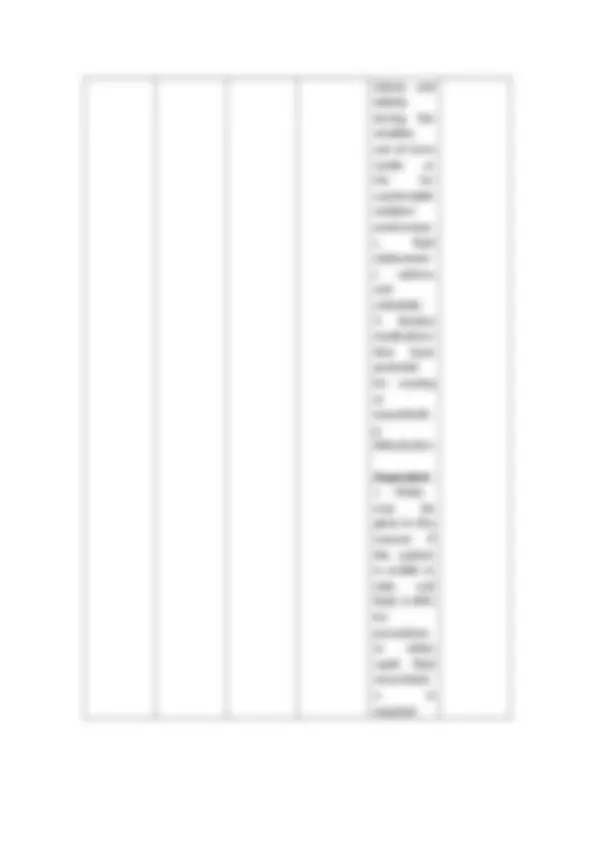Download It is about case presentation and more Study notes Nursing in PDF only on Docsity!
ASSESSMEN
T
DIAGNOSIS PLANNING INTERVENTI
ON
RATIONALE EVALUATIO
N
Objective:
- general body weakness
- poor skin turgor Risk for deficient fluid volume related to factors influencing fluid needs (hypermetab olic state) After 8 hours of nursing intervention , the patient will be able to: - Identify individual risk factors and appropriate intervention s. - Maintain fluid volume at a functional level as evidenced by individually adequate urinary output with normal specific gravity, stable vital signs, moist mucous membranes , good skin turgor, and prompt capillary refill. - Demonstrat e behaviors Independen t: 1. Note client’s level of consciousne ss and mentation 2. Assess older client’s “hydration habits” 3. Evaluate nutritional status, noting current intake, type of diet (e.g., client is NPO or is on a restricted diet). Note problems (e.g., impaired mentation, nausea, fever, facial injuries, immobility, insufficient time for intake) 4. Review patient's medications ,including prescription Independen t: 1. To evaluate ability to express needs 2. To determine best approach if client has potential for dehydration . Note: A recent study identified four categories of nursing home residents: (1) Can drink (the client is functionally capable of consuming fluids, but doesn’t for any number of rea- sons), (2) can’t drink (frailty or dysphagia makes this cli- ent incapable of After 8 hours of nursing intervention, the patient was able to: - Identified individual risk factors and appropriate interventions. - Maintained fluid volume at a functional level as evidenced by individually adequate urinary output with normal specific gravity, stable vital signs, moist mucous membranes, good skin turgor, and prompt capillary refill. - Demonstrate d behaviors or lifestyle changes to prevent development of fluid volume deficit.
or lifestyle changes to prevent developme nt of fluid volume deficit. ,over-the- counter drugs, herbs, and nutritional supplement s,
- Monitor I&O balance, being aware of altered intake or output
- Assess skin turgor and oral mucous membranes
Determine individual fluid needs and establish replacemen t over 24 hours
- Discuss individual risk factors, potential problems, and specific intervention s
- Review appropriate use of medications Dependent:
- Provide consuming fluids safely), (3) won’t drink (client may fear incontinenc e or may have never in life consumed many fluids), and (4) end of life.
- These conditions/s ituations can negatively affect fluid intake of the patient
- To identify medications that can alter fluid and electrolyte balance. These may include diuretics, vasodilators , beta- blockers, aldosterone inhibitors, angiotensin -converting enzyme (ACE)
infants and elderly during hot weather, use of room cooler or fan for comfortable ambient environmen t, fluid replacemen t options and schedule).
- Review medications that have potential for causing or exacerbatin g dehydration Dependent:
- Fluids may be given in this manner if the patient is unable to take oral fluid, is NPO for procedures, or when rapid fluid resuscitatio n is required.












